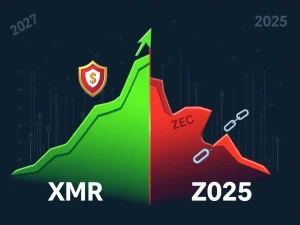Bitcoin Hashrate: Alarming 15% Plunge Signals Unprecedented Shifts in Mining Landscape

The world of cryptocurrency is buzzing with news of a significant shift in the Bitcoin landscape. Since June 15, the Bitcoin hashrate has experienced a dramatic downturn, plunging by approximately 15% in what marks the steepest decline seen in three years. This sudden drop has sparked intense speculation across the globe, prompting experts and enthusiasts alike to question the underlying causes of this unprecedented event. What factors are truly at play behind this major dip in Bitcoin’s computational power?
Understanding the Recent Bitcoin Hashrate Decline
The numbers speak volumes: from nearly 943.6 billion terahashes per second (TH/s) on June 15, the Bitcoin hashrate plummeted to 799.9 TH/s by June 24. This substantial decrease, over 15%, brings the hashrate to levels not witnessed since May. This metric represents the total combined computational power being used to mine and process transactions on the Bitcoin network. A higher hashrate generally indicates greater network security and miner participation. The recent fall, therefore, raises questions about the health and stability of the network.
Geopolitical Shadows: Is Iran Impacting Crypto Mining?
One prominent theory circulating in the cryptocurrency community points to Iran as a potential catalyst for the crypto mining decline. Iran is known for its large-scale Bitcoin mining operations, with some reports even linking them to local power outages.
- June 20 Internet Blackout: The Iranian government imposed a near-total internet blackout, coinciding with a 2.2% drop in global hashrate (from 884.6 million TH/s on June 19 to 865 TH/s on June 20).
- June 22 US Strike: A US strike on Iranian nuclear facilities reportedly led to electric grid outages, aligning with a 1% fall in global hashrate (from 869.9 million TH/s on June 21 to 860.9 million TH/s on June 22).
However, closer examination reveals that only a small fraction, just over 3%, of the total hashrate decrease precisely aligned with these events. Furthermore, the hashrate was already in a steep decline, falling over 6.25% between June 15 and June 19, before these specific incidents occurred. This suggests that while Iranian events might have exacerbated the situation, they were likely not the sole, or even primary, cause of the broader hashrate drop.
Economic and Environmental Pressures on the Hashrate Drop
Beyond geopolitical events, economic and environmental factors appear to be significant contributors to the recent hashrate drop. Two major elements stand out:
- Rising Electricity Prices: Mining Bitcoin is an energy-intensive process. As electricity costs surge, the profitability of mining operations diminishes. This can force less efficient or higher-cost mining facilities to reduce operations or shut down entirely.
- Ongoing Heatwave in the US: The United States, a major hub for Bitcoin mining, has been experiencing severe heatwaves. High temperatures negatively impact mining efficiency, as equipment performs optimally within certain temperature ranges. Overheating can lead to reduced output or even require miners to power down to prevent damage. This increased power demand also drives up electricity prices, creating a double whammy for miners. For instance, New York-based utility Con Edison recently urged customers to conserve energy during the heatwave, leading to peak power prices in some regions.
The Bitcoin Network’s Resilience and Measurement Challenges
It’s crucial to understand that the Bitcoin network hashrate is not directly measured. Instead, it is an estimate derived from the block time and current mining difficulty. Mining difficulty indicates the average computing power needed to find a valid block. Because real-world mining involves significant variations based on chance, this calculation is inherently imprecise. This imprecision means that while the Iran theory might be less impactful than initially thought, a definitive dismissal is difficult. Market observers largely agree that a complex interplay of geopolitical, environmental, and economic pressures is at play, rather than a single dominant factor. The network’s design, however, includes difficulty adjustments that help maintain block times around 10 minutes, ensuring its long-term stability despite fluctuations in hashrate.
Navigating the Future of Mining Profitability
The recent events underscore the dynamic challenges faced by those involved in mining profitability. Miners are constantly balancing operational costs, equipment efficiency, and market conditions.
Challenges for Miners:
- Fluctuating energy prices and availability.
- Need for efficient cooling solutions, especially in warmer climates.
- Geopolitical risks and regulatory uncertainties.
Path Forward: To maintain and enhance profitability, miners may need to:
- Invest in more energy-efficient hardware.
- Explore locations with abundant and cheap renewable energy sources.
- Diversify their operations to mitigate regional risks.
- Adopt advanced cooling technologies to combat heat.
The industry’s adaptability will be key in navigating these evolving pressures.
The recent 15% drop in Bitcoin’s hashrate is a stark reminder of the multifaceted influences on the cryptocurrency ecosystem. While initial speculation quickly pointed to geopolitical events in Iran, a deeper analysis reveals a more complex picture, heavily influenced by rising electricity costs and the intense summer heatwaves in major mining regions like the US. This event highlights the inherent challenges in crypto mining and the intricate balance miners must maintain. Despite these fluctuations, the underlying resilience of the Bitcoin network, with its adaptive difficulty adjustments, ensures its continued operation. As the industry matures, understanding and adapting to these intertwined environmental, economic, and political forces will be paramount for the sustained health and security of the Bitcoin blockchain.









